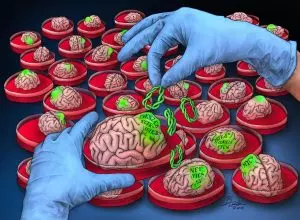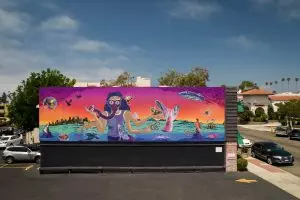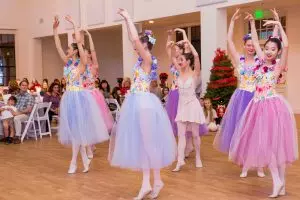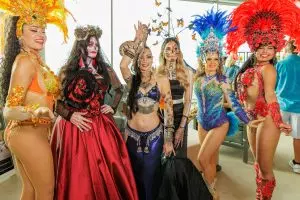Spotlight on San Diego’s science culture during PST: Art

The third iteration of PST: Art, once just called Pacific Standard Time, kicks off in September with a region-wide focus on the intersection of art and science. With at least $20 million in funding from Los Angeles’ Getty Center, over 80 Southern California institutions had four years to prepare with scholarly research trips, commissioning artists, excavating their archives, borrowing artifacts and developing events.
San Diego’s life sciences are one of the reasons Getty granted $2,090,000 to local institutions for PST: Art and Science Collide. UCSD, San Diego Public Library, La Jolla Historical Society, San Diego Museum of Art (SDMA), Mingei International Museum, and Museum of Contemporary Art San Diego (MCASD) are among the places where PST: Art exhibits will be on display starting in mid September.

“Riva and Zora in Middle Age”
will be on in view in For Dear Life from the Collection of
Michael and Michelle Minns.
“It’s not surprising to us that San Diego/La Jolla would be so strong for this edition because there’s such an incredible history of science in the region,” said Heather MacDonald, senior program officer at the Getty Foundation. MacDonald explained the Getty put out an open call in 2019 and received 150 letters of interest. Of those, 80 were selected to submit a full proposal and 40 received full funding. Others, like the New Children’s Museum, went on to receive phase two programming funding.
With the added theme of science to what previously focused on art culture and history, local institutions like Birch Aquarium at Scripps Institute of Oceanography are participating in PST: Art for the first time. Others, like the Mingei Museum, received full exhibit funding rather than just programmatic funding for the first time, allowing the folk arts museum to have the largest exhibit ever, taking up the entire second story of its Balboa Park building.
“By design, the Getty structure allows you to do larger exhibitions,” said Kathryn Kanjo, director and CEO of MCASD, which has a group exhibition of over 80 sick and disabled artists in “For Dear Life: Art, Medicine and Disability.” The first ever survey of American art responding to unruly bodies from the 160s to today is also PST: Art’s largest exhibition by square footage. The theme came about, Kanjo said, because “we were looking at the way artists respond to science, and we think that lots of times it comes from a personal point of view. At other times it reflects larger cultural movements.”
Kanjo praised the initiative for being broad enough that each institution can respond to the theme while still cleaving to their identity. “It’s great to be part of this larger effort, but it’s also an initiative that allows each institution to put forward its own type of project,” she said.

Another landmark exhibition is occurring at SDMA with “Wonders of Creation: Art, Science and Innovation in the Islamic World.” Curator Dr. Ladan Akbarnia believes no other exhibit on Islamic civilization of its size has taken place in San Diego. Akbarnia authored the project proposal submitted to the Getty shortly after she was hired by SDMA in 2019. A general topic like geometry felt outdated to Akbarnia. “Even though I knew this would be the first exhibition on Islamic visual culture in San Diego and that ultimately those of us who are in this field often have to introduce this material to people rather than expect them to know what some of these images mean or what languages are involved, I didn’t want to approach it as a general introduction,” explained Akbarnia.
The show details innovations in scientific theory and craft practices in the Islamic world through the framework of a 13th century text describing wonders of the universe. Among the commissioned art and major loans, works from the Islamic Arts Museum Malaysia will be in the U.S. for the first time for the exhibit.

The length of time institutions had to research, negotiate to borrow pieces and commission art meant those who proposed the exhibits were not always still on staff by the time PST: Art kicks off. Mingei co-curator Emily Hanna came to the museum after her predecessor had already selected indigo as a topic, leaving her to finish the museum’s biggest show since its renovation alongside co-curator Guusje Sanders and guest co-curator Barbara Hanson Forsyth. Hanna noted since the proposal there were “so many shifts. It was even before COVID.” The resulting exhibit, “Blue Gold: The Art and Science of Indigo,” looks at how cultures around the world pioneered complex processes to make indigo dye from indigo plant varietals then developed craft techniques around the resulting dye. Visitors can go into a deep dive on the science of indigo or simply view the global spectrum of indigo crafts. The show also grapples with indigo’s association with slavery and colonialism and its environmental impact today.
“With art, we can shed light on some of the nuances of science,” said Megan Dickerson. She left the New Children’s Museum in Sept. 2021 to become director of exhibits at Birch Aquarium. Already, 30 artists were selected for “Embodied Pacifics” and paired up with oceanographers to create work exploring those scientists’ research. Their pieces will be displayed across multiple sites, including UCSD and the aquarium. Like indigo, Dickerson noted ocean technology has not always been used to the benefit of all people or the environment. PST: Art gives the public an opportunity to learn about oceanography in a new way. “In this time of climate crisis, we really need to be rethinking how we’re talking about this work,” Dickerson said.

One of her favorite things about “Embodied Pacific” is how artists have helped scientists see their work differently. PST: Art in general gives the community space to have conversations on the nexus of art and science. She said, “PST is this force creating these contact spaces all over where we are grappling together.”
Another aspect of San Diego’s PST: Art participation bringing focus to the region are biographical exhibits on the most significant artists tackling scientific topics in California history.
“There’s a larger group of participants and quite significant exhibitions [in San Diego County],” Getty’s MacDonald said. She asserted ecological artists Helen and Newton Harrison were name checked the most in PST: Art & Science Collide applications yet the only show dedicated to the couple is taking place in San Diego. In “Helen and Newton Harrison: California Work,” some of the projects the couple created from the 1960s to the 2000s are being revived at the Central Library gallery, Mandeville Art Gallery at UCSD, California Center for the Arts Escondido and La Jolla Historical Society. MacDonald said this will be a once-in-a-lifetime chance to see archives of California’s historic environmental art, such as the 60-panel, 360 degree photo mural “The Lagoon Cycle” which has not been on display since at least 1997.

Another significant California figure is science fiction author Octavia E. Butler. American Artist recreated and filmed a rocket launch from Butler’s “Parable” series that will be on view at Los Angeles County Museum of Art (LACMA). Further south, a more biographical look at Butler’s childhood influences are the subject of a room-sized installation at New Children’s Museum. The exhibit has been open for a few months but the museum has special PST: Art events and upcoming installations from artists Cannupa Hanska Luger and Saya Woolfalk on how science fiction offers ways to imagine better futures.
The five-year initiative PST: Art & Science Collide culminates in six months of exhibits, installations and events across Southern California beginning this month. “There’s a lot of elements that will make San Diego County a really exciting place to experience PST: Art,” MacDonald said. For information on all participating institutions and events, visit pst.art.
Top photo: A still from “Embodied Simulation” by Memo Akten and Katie Peyton Hofstadter (Photo courtesy Birch Aquarium)
Categories
Recent Posts










GET MORE INFORMATION


